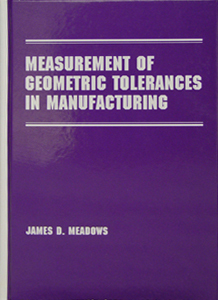|
Generously illustrated
with hundreds of drawings and explaining the language of geometric
symbology to clarify technical points, Measurement of Geometric
Tolerances in Manufacturing is a practical guide for mechanical,
manufacturing, design, quality control, project, process, industrial
automation, automotive, and aerospace engineers and managers;
metrologists; draftspersons; and upper-level undergraduate,
graduate, and continuing education students in these disciplines.
James D. Meadows has
written some of the wonderful (and real) stories he tells in his
training sessions to illustrate technical points and clarify
concepts...you'll discover that learning really can be
"entertaining".
Contents:
Introduction to Measurement Principles
[Once Upon a Time...in the Land of Measurement]
Condition Illustration
Verification of Position with Open Set-Up
Geometric Product Definition and
Measurement, Inspection and Gaging Principles
[Just Talk the Talk]
How to Read a Feature Control Frame
How to Read a Feature Control Frame for Purposes of Measurement
Reading the Feature Control Frame
[For a Functional Understanding and To Guide Product Measurement]
Functional Product Definition Creates
Functional Inspection
[Inspecting Parts as They are Used]
Functionality Can Be Used to Suggest Manufacturing Procedures
Multiple Possibilities of Dimensioning and Tolerancing for
Functionality and Inspectability
I Can't Measure That
Functionality vs. Producibility
The Things I've Seen (Where Tolerances Come From)
Hog-Tied and Cow-Chipped (Importance of Geometric Definition)
Correct and Complete (Tips on Functional Product Definition)
Miles to go Before We Sleep (Importance of Geometric Definition)
Plastic Parts and Stretch Tolerances
Design, Inspection, Production, and Prototype Needs and Capabilities
Regarding
Dimensioning and Tolerancing
Implying a Manufacturing Sequence on Complex Part Configurations
Principles of Measurement for Geometric
Characteristics
Geometric Characteristic Symbols
Straightness; Flatness; Circularity; Cylindricity; Parallelism;
Angularity-Orientation Category;
Profile of a Surface
Composite Profile vs. Two Single-Segment Profile Controls
Coplanarity
Conicity
Profile of a Line
Circular Runout
Total Runout
Concentricity
Symmetry
Inspecting Threaded Holes
The Boundary Concept
Composite Positional Tolerancing vs. Two Single-Segment Positional
Tolerancing Controls
Comparison of Controls [Food Chain of
Symbology]
2-D vs. 3-D Controls
Comparison of Coaxiality Controls (Position, Concentricity, Circular
Runout, Total Runout)
Concentricity vs. Runout
Datums [When Sweet Seeds Grow Rancid Fruit
(How to Select Datum Features)]
Part Stabilization (Datums for Flexible Parts)
Sequential Part Definition vs. Simultaneous Requirement (The Game of
Leaders and Followers)
Datum Features
Simultaneous and Separate Requirements
Datum Target Assignment
Oddly Configured and Curved Surfaces as Datum Features
Free State Variation in Sheet Metal Parts
Material Conditions (Modifiers) - Meaning
and Uses
Maximum Material Condition
The Maximum Material Condition Symbol and Its Ramifications
Allowed vs. Actual Deviation from True Position
Least Material Condition (Meaning and Uses)
Regardless of Feature Size
Virtual and Resultant Condition
Boundaries
Virtual Condition-a Functional Boundary
Surface vs. Axis Verification
Zero Positional Tolerancing at MMC for a Greater Yield
Gaging--Principles, Terms and Examples
Gage General Principles
Gaging Size Limits; Terms
A Few Major Measurement Concepts
Gaging a Complex sheet Metal Part
General Principles and Terms of Tolerance Compliance
Merging Theory with Reality [Having the
Right Measurement Tool]
Theory vs. Reality (Uncertainties)
Reactions to a Non- Perfect Datum Establishment
How to Improve Quality [The Zen of
Quality]
Tying Measurements to the Machine
How Many Points Should I Probe?
The Search for Common Sense (Statistics Out of Control)
Quality Issues from the Afterlife (Slogans vs. Programs and
Planning)
Focus and Excel (Maximizing your Abilities)
Competing in a Global Economy (Great Products at an Affordable
Cost)]
Inspection Planning
Dimensional Inspection Planning
Methodical Measurement
Sources of Measurement Error
[What We Know Is Often Untrue and Other Sources of Measurement
Error]
CMM Error compensation
Certification vs. Calibration
Graphical Inspection Techniques and
Examples
Graphical Techniques and Inspection Reporting
Comparison of Measurement Techniques and Equipment (Advantages and
disadvantages
Teamwork Issues [Unity of Purpose Affects
the Bottom Line]
Concurrent Engineering-Key to Our Future
Magical, Mystical Stuff (Doing Something vs. Doing Nothing)
Avoiding Tiger Pits . . . While Helping a Leopard Change Its Spots
Training Issues [I Wonder as I Wander;
Training: An On-Going Process]
Statistical Process Control [Faulty
Implementation--Wonderful Concepts]
Concepts of Statistical Process Control; Statistical Tolerancing]
Letters: Common Problems and Their
Solutions [The Good, The Bad and The Really Weird]
-I See the Light at the End of the Tunnel, But It Could Be a Train
-Explosives and a Cell Mate Named Bubba . . . or Training
-Shakin' Like a Dog Passin' Peach Pits
-My Boss Just Died and I Feel Fine
-Bad Meat . . . and No Mayo
-Low Foreheads, Bad Instincts, and Hangdog Looks
-GD&T Questions I Can't Take Any More
|









